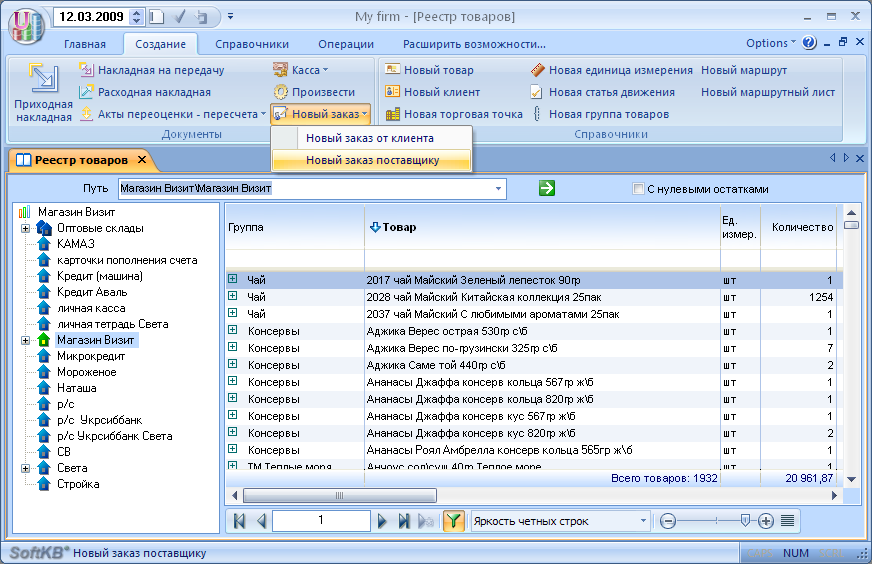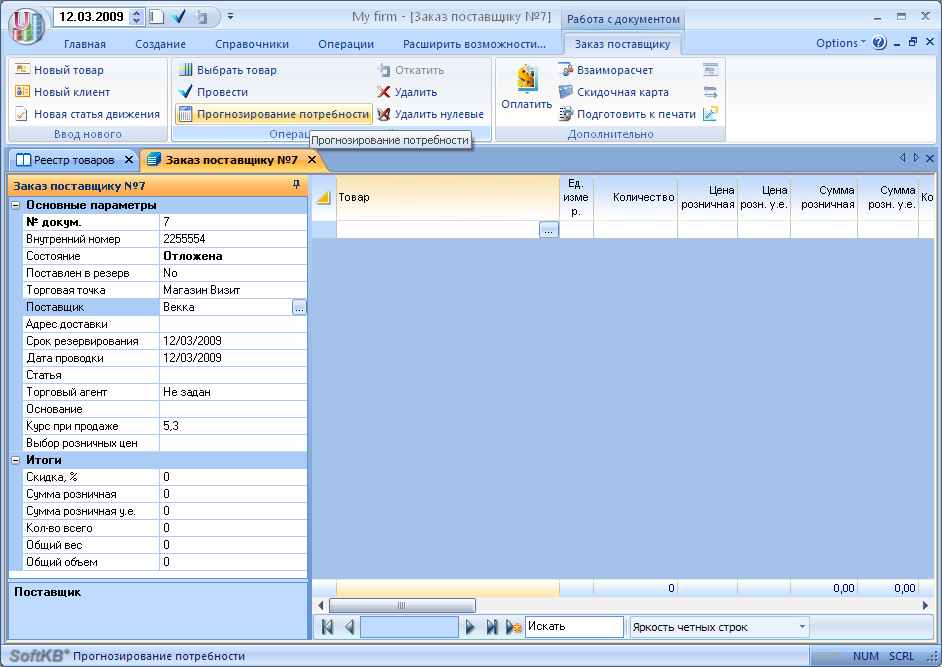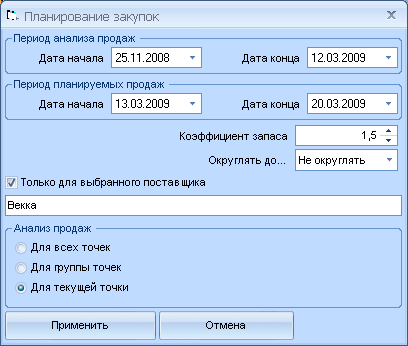There this problem, I call it "washout range". Pay attention --
shop opened, the goods of different interesting and full of trips to this store
want, and buy something not give. But time passes, say,
six months. Shop does not know. Previously, five types of oil was now the force of two.
Earlier in refrigerators and shrimps of various calibres were offered, but now
remained one pack, and the prawns have turned from red to red, and the stack
exactly, no one will buy it, no one even deign to steal (steal bad).
Looking for something to do. Ideally, when building an application provider wishes to
a «magic button», when you click on that, the order would be formed
fully automatically. Oddly, the design we met at this
«Technical task».
Let us consider in more detail how the automatic
building applications for the supplier. To this end, in the register of goods TTSU,
switch to the point where the supplier usually delivers the goods. This may be
central warehouse, where goods are distributed to outlets. This may
be a point of sale, if the supplier delivers the goods directly to the
point. For example, dairy products are often shipped directly to the store, bypassing the
store. In ribbone tab «Creation» and select «New Order
supplier».

A new order, choose the supplier. In our case it is «Vecchio». Task
is that in order automatically to include all products
supplied «Vecchio» in the last time. This procedure is called
«Calculation range». Once your range is,
system must determine our needs for the future. The need for
product is determined from the average demand multiplied by the number of days
future period. In turn, the average demand is easy to calculate,
estimating the volume of sales of the product for a period and divide this amount to
Number of days period.
As it turns out confused. Let us in a simple, at
fingers. During the month of January (31 days), we have sold 122 kg of sausage. So, one day
We sell an average of 122/31 = 3,935 kg. Deliver goods to our supplier again
week. So, we need to order the product at 7 days of sales. Taking that
sales in February, will be approximately equal to January, we evaluate our need for
sausage: 3,935 * 7 = 27.548 kg.
As you can see, nothing complicated. In real trade
introduce more such a thing as a safety factor. Not really want to stay
last two days, just without the sausage. Typically, this ratio is equal to 1.5
(half), but the program we will be able to regulate it. In addition, because
ordered amount must be deducted already. That's up to us
simple formula: (the average sales for the period * Number of days
planned sales * 1.5) - (balance at the moment the recipient at the time of booking).
Let's see how it works. On the content tab, select the order of our
«Anticipation needs».

A form of procurement planning.

Period analysis of sales allows us to form
range of the supplier. We just get a list of goods that
vendor supplied us with during this period.
The second task, which involved
during the analysis of sales - the average estimate of sales for the period. Period
can be set arbitrarily. What period of more, the rich assortment of topics and
a «medium» to be our average sales. How to deal with this period
- Will come with experience. It has its nuances. And the material would be enough for another
article. For example, it is not always good to increase the period of analysis, especially for
seasonal items. Another interesting point - if the approaching holidays, the
it would be interesting to «hook» previous holiday period, but there are
features. March 8, it is not New Year's Eve, and preferences of the population to these
different occasions on one product and the same for others. In general, the steering wheel we
You pay in the hands, which arrive here, there and zanochuete.
Since the period of planned
sales are much easier. The resulting average sales simply multiplied by
number of days of this period to assess the needs.
Since the safety factor
seem to be any difficulties, too, with rounded, too, understand.
Tick
«Only the selected supplier» limits the calculation range of only
specified in the order of the supplier. If it is deleted, it will be a squash! Thus, it is not
More. Read this: «If you remove the tick, the range will be included
goods supplied by all vendors for the period of analysis ».
Well, the last
group settings, called «The analysis of sales». It has three modes:
- «For
all points ». Used when goods are delivered to a central warehouse,
after the overhead allocated to the transmission of outlets, and we
need to calculate sales from all outlets.
- «For the point group».
When the supply goes to a local warehouse, where goods are distributed on
outlets within the current group. For example, if a department store and
shop together in one group and we are interested in selling only within the
referred to the store.
- «To this point». When the sale goes to the same
the point where the goods are delivered. The most frequently used in simple
business structures.
When using the settings defined, click the button
«Apply», and after the second break (a request to the server to obtain
range of goods) starting to watch «magical process» automatic
completing our application. I get like this:

Do you?
P.S.
If you do not succeed after such a detailed article, well, write in the forum, promise that answer.